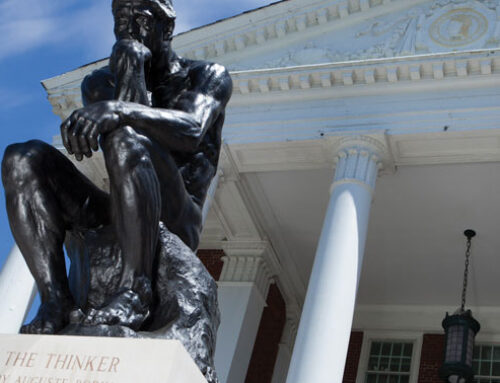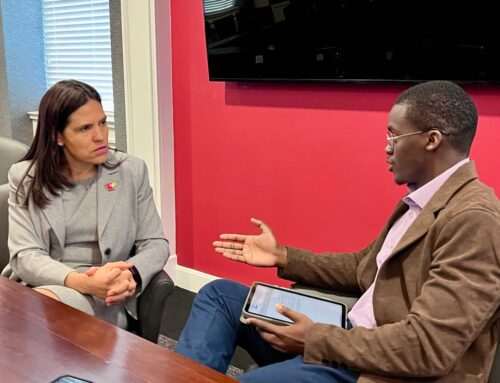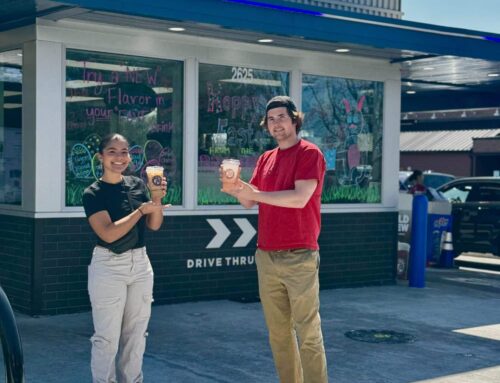It was an abnormally cool September morning on the New York City streets. Business men and women walked with heavy strides, dressed for the work day. All around, people went about another busy Tuesday morning in the city. The sound of taxis honking and people shouting were heard around each sharp corner. Elevators worked overtime delivering thousands of people to work in the World Trade Center towers and other surrounding buildings.
Louisville businessman Sean Higgins decided he would grab a coffee and read over his notes at the Starbucks in the first floor lobby of the North tower. He had a business meeting for the business we worked for, Cisco Systems. The meeting was at nine o’clock a.m. in the Wall Street building adjacent to the twin towers of the World Trade Center. As he walked out of the tower, the only thought in his mind was whether to get regular, or decaf.
Only a single moment after walking out the door, he recalls hearing a sudden muffled explosion noise above him. When he looked up, he saw bursting flames and debris escaping windows from dozens of floors above. The heat of the explosion hit him in the back as he ran away from the tower nut sure of what had occurred. The glass from the first floor had shattered just moments after he had run off. The fire explosion from the planes’ impact had sent a ball of fire down the elevators and out the doors instantly shattering the glass in the lobby on the first floor. Two women he had bumped into in the plaza held each other in their screams.
“It was like two trains crashing into each other. I grabbed the two ladies and we ran in shock towards building number five and tucked ourselves into a corner.” Building number five was a nine story low-rise building across the plaza from the World Trade Towers. When he looked up, he saw bursting flames and debris escaping windows from dozens of floors above.
“It was not until we had tucked ourselves in the corner of the building that we learned the explosion we had witnessed was actually an American Airlines plane,” said Higgins. Debris fell like rain onto the surrounding streets. The security guards began moving people from the lobby to the Hyatt Regency hotel a block away from building five of the World Trade Center Plaza on Church Street. The moment they walked out of the Hotel lobby, the second plane hit.
“It was horrible and chaotic, hundreds of people were running in every direction. The explosion of the second plane knocked me down on the sidewalk as we were trying to run away,” said Higgins. Higgins and the women he was with tucked themselves in the corner of the Hyatt lobby. First responders began to arrive. Dozens of fire trucks, police cars, and ambulances flooded the scene.
“The one thing I will never forget about that day is when I saw two firefighters hug each other and say I love you just before putting their helmets on and rushing into the towers,” said Higgins. The first responders rushed to get Higgins and others further away from the scene. They were escorted by New York police officers into another building. The building was called “Digital Sound Box,” a New York recording studio. Higgins and many others piled into the basement of the studio. They sat hip to hip along the walls of the basement talking and praying.
Higgins recalls, “I remember sitting in that basement just thinking about my kids and my wife. I wanted to hold them in my arms more than ever before.”
At approximately 9:59 a.m., the South tower fell.
“The ground shook like an earthquake. We were all afraid that the tower would fall over rather than on itself,” Higgins said.
The South tower fell, taking each floor down one at a time like a domino effect. At 10:28 a.m., the North tower fell. The city trembled.
“When the ground began shaking the first time everyone fell to the floor. Smoke and ash spewed in through the air vents and doorways of the basement. About 40 of us lied there coughing on ash scared out of our own right minds,” said Higgins.
Three hours later, Higgins and many others were told by police it was safe to leave the basement refuge. They climbed two staircases to a rear exit on the main level.
“The sky was as dark as night and it looked like there was snow on the ground,” said Higgins.
Higgins and many others routed to lower Manhattan to escape the haze and the sirens. Thirty blocks later, they reached midtown which is also known as “Hell’s Kitchen.”A lower-class area south of the city also called the “Irish Slums” for its large Irish-American demographic.
“I won’t forget the lady who appeared to be homeless on the side of the street. She offered us bread and milk that was sitting in her old shopping cart,” said Higgins.
Midtown is where Higgins and the two women he was with parted their ways. Higgins continued to walk further south towards Soho, an art district in lower Manhattan. Higgins, covered in gray ash from head to toe saw a J. Crew clothing store just down the block. Afraid to go inside looking the way he did, he began knocking on the door to get someone’s attention.
“I was so uncomfortable and dirty I just needed some clean clothes. A lady ran to the door with a lot concern on her face, and told me to pick out anything I needed. Those clean jeans and that t-shirt they gave me was the best thing that happened to me on that day,” said Higgins.
It was not until he had left the store and walked around the corner that he saw the rising smoke and the open sky where the towers once stood.
It was 1:58 p.m. when Higgins was finally able to get cell phone service and make a call home. Due to the large amount of cell phone traffic in the city, cell phone service was interrupted for hours surrounding the tragedy zone. The wireless networks were unable to withstand the large amounts of calling loads which left many people like Higgins, stranded without communication.
“I remember sitting at home with my parents and the kids around the telephone in our living room, just waiting for his call. I will never forget picking up the phone and hearing his voice,” said Sean’s wife, Lisa Higgins.
Higgins continued to walk for almost two hours until he reached lower New Jersey. He found a Hertz rent-a-car store just around the corner. He immediately rented a car and decided to drive home. Seven hundred and sixty-six miles and 12 long hours of driving, Higgins finally made it to Louisville.
“I took the car straight to my house, I was in such a rush to get inside and see my family that I left the car running in the driveway,” Higgins said.
His oldest daughter Riley remembers that day vividly.“I was in the fourth grade when it happened. It was so hard to understand what was going on and why. I had so many questions. That night my little sister, older brother, mom and I had fallen asleep on the couch in the living room. He got home really early in the morning. I remember hearing the door open and looking up to see him in the doorway. I had never been so happy to see my dad than I did in that moment.”
That day had a huge impact on Higgins and his outlook on life. One year after the tragedy, Higgins decided to quit his job to spend more time with his family. Working out of a suitcase and constantly on a plane or in a hotel took its toll. In the spring of 2006, Sean and his wife Lisa created their own Kentucky Bourbon Trail tour company called “Mint Julep Tours.”
Higgins designed the company to encompass fun and to show tourists the beauty of Kentucky. The business slogan presents a clear theme towards the goal of their company. Down the side of each of their four tour buses says, “The purpose of fun is to have some.” Today, the company has grown drastically with a headquarter office in the famous Galt House hotel in downtown Louisville.
“This is the life for me now. I get to spend more time at home with my kids and better yet I get to be with my wife every day. I have realized that life is too short and too precious. You have to begin concerning yourself with the little things in life to appreciate the big things,” said Higgins.





